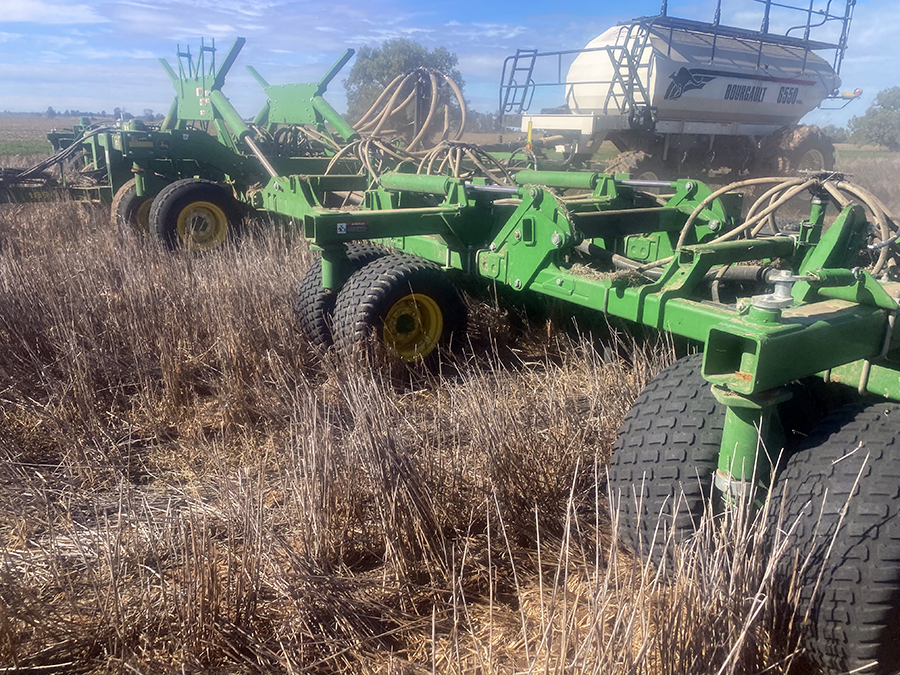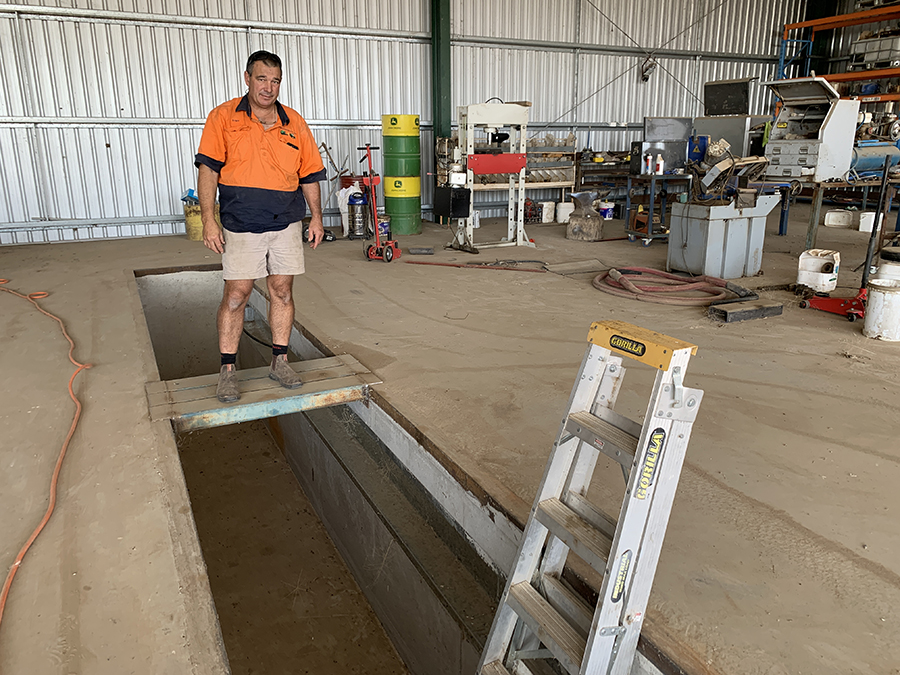Snapshot
Owners: Roger and Mitchell Bolte
Location: Wyalong, NSW
Area cropped: 6000 hectares
Average annual rainfall: 420 millimetres
Soil types: red loam to heavy black self-mulching clays, plus lighter country
Soil pH (calcium chloride): 5 to 6
Crops grown: wheat, barley, canola, chickpeas, vetch
Crop sequence: legume/canola/cereal/cereal
Roger Bolte has switched to disc seeding to maintain stubble cover and improve the reliability of harvesting crops in dry seasonal conditions.
The continuous cropper, who farms with his son Mitchell near Wyalong, New South Wales, told the GRDC Northern Region Update that he started looking at disc seeders when conditions were dry in 2017, 2018 and 2019. The father-and-son team made the switch to discs last year.
“We saw that people who retained their stubble were able to produce bigger yields in low-rainfall years,” he said.
He pointed to research that showed soil under disc-sown stubble was cooler than soil without cover and the stubble reduced soil surface wind speed.
He said this meant less soil water evaporation, which was important for his farm because grain yields were almost always limited by a lack of moisture.
Labour supply
Another reason for making the switch to disc seeding, he said, was a lack of labour.
“We’re finding labour is hard to find and hard to hold,” he said. “We felt that moving to a disc sowing system gave us a number of time management advantages.”
He said stubble only needed to be kept free of weeds through summer and there was no requirement to smash or burn stubbles ahead of sowing.
Burning or smashing stubble will never be ruled out, he said, but the labour requirement is less in the years that these operations are not required.

Roger and Mitchell Bolte’s new disc seeder sowing into stripper front stubble on their farm near Wyalong, New South Wales. Photo: Roger Bolte
In their first attempt at disc seeding with a trialled unit, Roger said he and Mitchell compared a disc-sown crop with a tyne-sown crop.
There was no difference in crop establishment because more than 114 millimetres of rain fell on the trial after they had finished sowing, which required resowing with their tyned machine because the disc seeding unit was no longer available.
On his farm, he said, his tyned machine bogged as easily as a disc seeder.
In 2021, which was one of the wettest starts to the season Roger has experienced, he said he had no more problems with the disc seeder than he would have had with his tyned machine.
“The disc machine handled the wet conditions as well as or better than our parallelogram tyne and press wheel rig,” he said.
“One of the biggest hurdles for me to overcome – was my feeling that a disc seeder would not handle our heavy, sticky soils.”
He found that with heavy stubbles, the depth wheels on his disc seeder remained clean despite the wet sowing conditions.
In 2021, some of his wheat crops yielded six tonnes a hectare.
Maintenance
When it comes to maintenance, Roger said he expects to change all the bearings on the disc seeder after three years. The actual discs need replacing every year.
He said he is interested to see how the discs perform under drier and more abrasive conditions. This might demand disc replacement partway through his 6000ha sowing program.
Roger said he has an 18-metre pit in the family’s workshop to facilitate easy disc replacement. The machine is backed over the pit, folded out and workers can stand up underneath the machine.

Roger (pictured) and Mitchell Bolte have had an 18-metre-wide pit put into the floor of their workshop to make working on their disc seeder easier. Photo: Nicole Baxter
“Disc machines are high-maintenance, but when you look at the time saved compared to having to smash or burn stubbles, we are happy,” he said.
When it comes to downforce, Roger said the centre section of the disc seeder had plenty of weight, but the lighter frames on the wings meant the discs tended to ride out of the ground.
Weight adjustment
He said the spring set-up on the machine was strong enough to penetrate most stubbles, but the bar needed more weight to prevent depth-control issues.
Each of the sections on the bar has hollow areas, where stacked layers of flat steel will be placed to add weight to the machine.
“We were chasing moisture in 2021 and we knew we sowed reasonably deep, but it was probably too deep in some areas,” he said. “Increasing the weight on the wings should improve the evenness of germination.”
Hair pinning in canola was a big issue in 2021. If he had the opportunity again, when sowing into extremely heavy stubbles, he said he would do a late burn.
He said hair pinning was not an issue when sowing cereals, but for canola, the emergence percentage was not as high as he would have liked.
One of the causes of hair pinning was when harvesters with a chopper produced very short, fine residue. It is this layer of debris that remains wet and heavy during sowing, which causes most of the hair pinning.
“Stripper front stubble has created fewer hair pinning issues because it leaves very little residue on the soil surface,” he said.
“The draper-front stubble, even with the chopper involved, results in heavy stubble cover on the centre of the rows compared with the outside of the rows, which led to poor canola establishment.”
Going forward, the pair will buy a second stripper front. This will allow them to take advantage of efficiency gains, which equate to an average harvesting capacity of 65 to 70t an hour.
Roger has the disc seeder set on 190.5mm (7.5 inch) row spacings, which, he said, had increased crop competition against weeds.
When he bought the disc seeder, he wondered how much stubble the machine could handle. He was answered in 2021 when he used the disc seeder to sow into the stubble of an 8t/ha wheat crop, and in wet conditions.
Roger said the disc machine sows at 10 to 12 kilometres an hour. He thought 298 kilowatts (400hp) would be enough to pull his 18m machine, but it was not quite enough in wet conditions.
“In dry conditions, our 298kW tractor could pull the disc seeder without issue, but in wet conditions, we were right on the limit,” he said. “We have ordered a 410kW (550hp) Quadtrac tractor, which will arrive in 2023.”
More information: Roger Bolte, rogerbolte@bigpond.com.au

























































